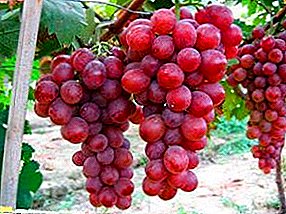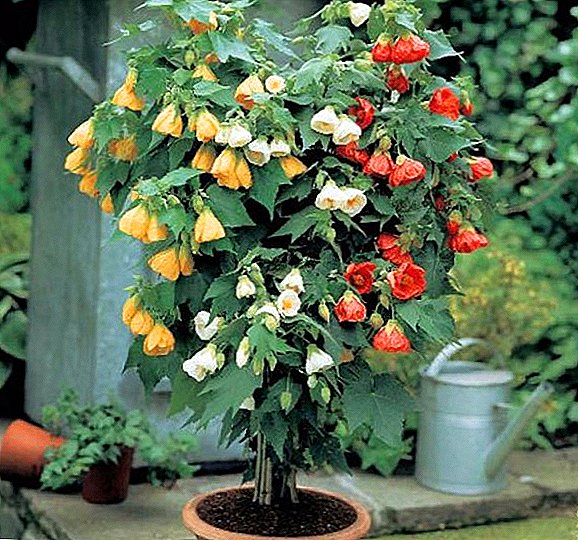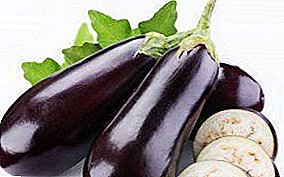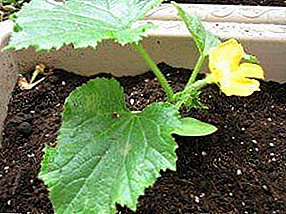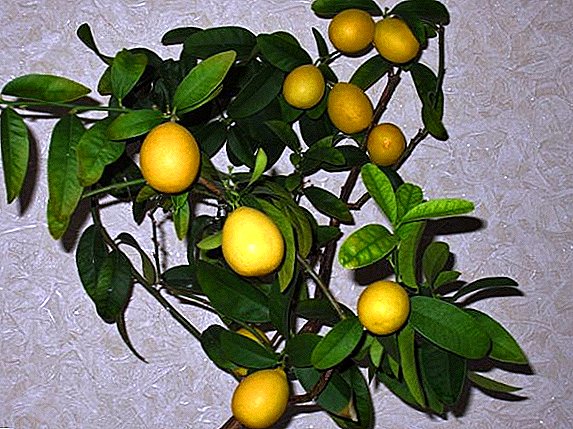 Raspberry "Brilliant" is a remontant variety that has large and juicy fruits.
Raspberry "Brilliant" is a remontant variety that has large and juicy fruits.
Their appearance is very beautiful, and they have a great taste. In this article we will discuss this type of raspberry.
History of creation
He was bred in Russia by the breeder I. V. Kazakov. The variety of remontant raspberry "Diamond" was included in the State Register of breeding achievements recommended for distribution in 2006. The patent holder is GNU VSTISP. 
Characteristics and characteristics of the variety
Consider the description of the variety and characteristics of raspberry "Diamond".
Did you know? 100 g of raspberry contains only 41 kcal. Also included are fructose and glucose, which nourish the human brain and improve the functioning of the cardiovascular system.
Bushes
Bushes are sprawling, no more than 150 cm high. Annual twigs have a reddish tint, and they have a small wax coating and spikes. Two-year-old shoots are light brown, with small thorns on them. The leaves are green, slightly curled, with sharp teeth at the edges.
Berries
The berries are medium, weighing about 4 g. They are purple with a pronounced brilliance. The taste is sweet and sour. The smell is pleasant, but not very pronounced. The flesh is juicy, but does not soften. 
Ripening and yield
This variety bears fruit on annual and biennial sprouts. You can start picking berries from the end of July until the first frost. The yield is high - about 75 kg with one hundred square meters.
Winter hardiness
This raspberry variety does not tolerate temperatures well below -24 ° C.
Use of berries
Berries are consumed fresh, boiled jam and jams. They decorate cakes, pastries, add them to yogurt. Also from raspberry it turns out tasty jelly, desserts, marmalade, juices, wine, brandy.
Check out the description and aspects of growing raspberry varieties: "Caramel", "Canadian", "Hercules", "Atlant", "Kirzhach", "Polka", "Barnaulskaya", "Ispolin", "Heritage".
What to look for when buying seedlings
Seedlings should be bought in nurseries. Their quality can be determined as follows:
- Shoot diameter should be approximately 10 mm;
- roots must be at least 15 cm long;
- on the planting material must be at least 2 shoots.
Choosing the right place
To raspberry "Brilliant" gave a good harvest, it is necessary to choose the right place for planting and further care of the bush.
Lighting
"Diamond" prefers to grow in sunny open areas that are protected from cold winds. The ideal place is the southern part of the garden, next to the fence or buildings.
Important! This type of raspberry does not tolerate even penumbra, so watch that the object that protects it from the wind does not cast a shadow on the bush.
The soil
The best soils are loam, chernozem, with good drainage. Air to the roots should flow easily. It is recommended to plant raspberries after legumes and cereals. It should not be grown after peppers, tomatoes and potatoes.
Did you know? Raspberry contains copper, which is part of many antidepressants. Therefore, if this berry is present in your diet, then stress will bypass you.
Site preparation
The place where culture will grow it is recommended to prepare in advance. If disembarkation is planned for autumn time, then preparation should be carried out a month before, and if in the spring - the site is prepared in the fall.  You need to dig up the earth on the spade bayonet and remove all the remnants of plants. Then the soil is fertilized: for 1 square meter it is necessary to keep humus (10 kg), superphosphate (50 g), potash fertilizer (30 g).
You need to dig up the earth on the spade bayonet and remove all the remnants of plants. Then the soil is fertilized: for 1 square meter it is necessary to keep humus (10 kg), superphosphate (50 g), potash fertilizer (30 g).
Read also about the cultivation, beneficial properties and varietal diversity of black raspberries (in particular, the variety "Cumberland"), as well as how to distinguish black raspberries from blackberries.
Planting seedlings on the site
Next, consider when and how to plant seedlings.
Timing
If you want to breed raspberry considered varieties, then this can be done in the spring, and in the autumn. In the autumn you need to focus on warm weather in the first month or early October. During this period, seedlings with closed roots should be used, in contrast to spring planting - this is how the culture takes root faster. Summer and spring planting will be able to please the delicious ruby berries. 
Scheme
Landing scheme:
- Open roots should be dipped in a mixture of mullein (3 kg), clay (1.5 kg) and water (4 l).
- Next, dig a hole for planting: diameter - 0.5 m, depth - 40 cm.
- A seedling in a vertical position should be immersed in a hole, and the root system should be gently straightened.
- Cover with fertile mixture.
- It is necessary to tamp the ground near the bush and create a roller out of it so that the water during the irrigation does not spread.
- Seedlings need to be watered using 1 bucket of water for each.
- Then you should grind the peat near-stem circle.
Competent care - the key to a good harvest
Raspberry requires constant attention. Consider how to care for her.
Watering
Raspberries need to be watered periodically if it doesn't rain. In dry weather, this event is held as the land dries. Water is necessary for bushes before flowering, during the growth of foliage, during fruiting.  In late autumn, before the frost comes, it is necessary to moisten the ground 0.5 m deep. Water for this is recommended to use 3 times more, so that the roots have a moisture reserve in the winter.
In late autumn, before the frost comes, it is necessary to moisten the ground 0.5 m deep. Water for this is recommended to use 3 times more, so that the roots have a moisture reserve in the winter.
Read also about the cultivation and varieties of yellow raspberries (in particular, variety "Yellow Giant").
Top dressing
In order for the harvest to be rich, it is necessary to fertilize the crop:
- at the beginning of spring, 20 g of urea diluted in 10 liters of water is used for 1 square meter. Additionally, you should add fertilizers containing potassium, nitrogen, phosphorus;
- the following feeding is carried out before the raspberry is about to bloom: superphosphate (3 tbsp.), potassium sulphate (2 tbsp. l) is diluted in 10 liters of water;
- after fruiting, fertilize with double superphosphate (2 tablespoons) and potassium sulfate (1 tablespoons), diluted in 10 liters of water;
- Once a month during the summer period, feed up with a solution of mullein (1: 5). On one bush you need 1 liter of solution.

Mulching
For raspberries to be healthy, it is necessary to maintain the moisture of the roots. Water is retained thanks to a thick layer of mulch. To do this, use peat, sawdust, humus or fine grass. If the soil is mulched, then the amount of water needed for the bushes. reduced several times. Mulch decomposes and feeds raspberries with organic matter. Thanks to this method, it is difficult for pests to get into the soil for wintering.
Preventive treatment
The culture may be subject to fungal diseases and be affected by pests, therefore, in early March it must be processed. Prior to the beginning of the growing season, after the pruning procedure, the bushes should be sprayed using Bordeaux liquid.
Important! Remember that any processing of raspberries is effective only before flowering. In case of late it is necessary to sacrifice the harvest.
The following processing is carried out from spider mite before raspberry blooms: colloidal sulfur is used. Approximately at the same period, powdery mildew prevention is carried out - Topaz is one of the most effective means. 
Garter
The shoots of the raspberry variety are leaning towards the ground, breaking under the weight of the berries. Therefore, a garter is needed.
It is possible to use a pole for each plant whose height is 2 m. It should be dug to a depth of 0.5 m and a bush should be tied to it.
A popular way to maintain plants is a trellis. It is necessary to take 2 columns and dig them in, leaving 3 m between them. Next, you need to install additional supports between the posts and stretch the bottom line of the wire at a height of 80 cm, the rest will be at a height of 1 m and 1.2 m from the ground.
Shoots tied to the wire neatly and one by one. Thus, the berries will be well lit and mature. 
Pruning
If the culture is grown on annual shoots, then the entire part above the ground is cut in the fall. In the spring the bush is thinned, leaving about 6 of the best stalks.
When growing raspberries and on two-year-old shoots, it is necessary to leave annuals in autumn - in the spring they will woody and will bear fruit.
In the case of freezing of the shoots during the winter period, they must be cut to the first live kidney, as well as to remove damaged and poorly developed branches.
Preparing for the winter
The quality of the crop depends on the correct preparation for winter.
If raspberries are grown as an annual crop, then it is necessary to cut off all branches at the root and grind with peat, humus, sawdust. With the arrival of spring, when the snow has come down, it is recommended to remove the mulch, so that there are no problems with root swelling.
If annual shoots are left, then you should stretch the wire at a height of 30-40 cm and tie the branches to it before the first frost. The snow will be shelter for the bushes. If the culture grows in little snowy areas, then it must be covered with a film, agrofibre. After the first snow, it is desirable to rake him closer to the roots.
With quality care for raspberry bushes, you can harvest a good crop, starting from mid-summer and until the first frost.


